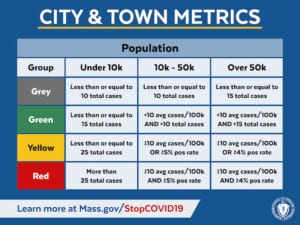Who is a member?
Our members are the local governments of Massachusetts and their elected and appointed leadership.

The COVID-19 Weekly Public Health Report will now incorporate population size and test positivity rate to determine the risk level of each community.
Gov. Charlie Baker announced today that the state is introducing new metrics and changes to the weekly community-level COVID-19 data reports.
The result is a more nuanced process that incorporates population size and the test positivity rate into the coding system, along with the daily number of cases per 100,000 people metric that has been used since August.
The color-coding system will continue to categorize communities as higher risk (red), medium risk (yellow), lower risk (green), and undesignated (gray). This change will reduce the number of red communities and increase the number of cities and towns identified as yellow, green or gray.
The weekly community reports will continue to be published on the state’s website every Thursday, although this week’s granular report and map has been delayed due to the transition to the new rating system.
Communities that have been designated as higher risk (red) for three weeks must revert to or remain in step 1 of Phase 3 of the reopening process. To move from step 1 to step 2 of Phase 3, communities must be either gray, green or yellow for three consecutive weeks.
Education Secretary James Peyser and Department of Elementary and Secondary Education Commissioner Jeff Riley joined Baker at the press briefing to announce that DESE has issued updated guidance to all school districts, encouraging all communities to prioritize in-person learning to the greatest extent possible, regardless of risk categorization, unless there are suspected cases of in-school transmission.
Mary Beth Miotto, vice president of the Massachusetts Chapter of the American Academy of Pediatrics, said she has seen “disturbing trends” resulting from children not being in school, including weight gain and an increase in mental health hospitalizations due to isolation and increased screen time.
The administration said that decisions to operate schools remotely, in person, or in a hybrid format will continue to be made at the local level, though DESE is calling on districts to prioritize in-person learning as the best and most healthy option for students.